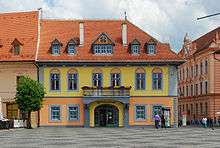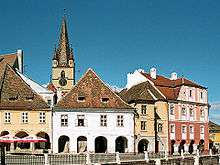Germans of Romania
.png) Distribution of Germans in Romania (2002 census) | |
| Total population | |
|---|---|
| 36,042[1] | |
| Regions with significant populations | |
| Transylvania, Banat, and Bukovina | |
| Languages | |
|
Mainly German (Hochdeutsch) but also Romanian and Hungarian | |
| Religion | |
| Lutheranism and Roman Catholicism | |
| Related ethnic groups | |
The Germans of Romania or Rumäniendeutsche are an ethnic group of Romania. During the interwar period in Romania, the total number of ethnic Germans amounted to as much as 786,000 (according to some sources and estimates dating to 1939),[2][3] a figure which had subsequently fallen to circa 36,000 as of 2011 in contemporary Romania.
Classification
The Germans of Romania are not a single, unitary, homogeneous group, but rather a series of different sub-groups, each with their own culture, traditions, dialect(s), and history. This stems from the fact that various German-speaking populations arrived on the territory of present-day Romania in different waves or stages of settlement, initially as early as the High Middle Ages, firstly to southern and northeastern Transylvania (some of them even crossing the outer Carpathians to neighbouring Moldavia and Wallachia), then subsequently during the Modern Age in other Habsburg-ruled lands (such as Bukovina, at the time part of Cisleithania, or Banat), as well as in other areas of contemporary Romania (such as Dobruja).

Therefore, given their rather complex geographic background, in order to understand their language, culture, customs, and history, one must regard them as the following independent groups:
- Transylvanian Saxons – the largest and oldest German community on the territory of modern-day Romania (often simply equated with all Romanian-Germans);
- Transylvanian Landlers – expelled Protestants (Evangelical Lutherans) from Salzkammergut, Austria to southern Transylvania during the 18th century);
- Most Banat Swabians as well as the entirety of Sathmar Swabians[4] (both representing sub-groups of Danube Swabians in Romania);
- Bukovina Germans – once with a sizable or overwhelming demographic presence in all urban centres from the historic region of Bukovina (specifically Suceava, Gura Humorului, Siret, Rădăuți, Vatra Dornei, and Câmpulung Moldovenesc) or some rural areas of the nowadays Suceava County in northeastern Romania; equally indigenous to Cernăuți and contemporary Chernivtsi province in western Ukraine between the years c. 1780–1940. Furthermore, still to this date Suceava County is one of the Romanian counties with some of the most significant amount of ethnic Germans in the country;[5]
- Zipser Germans, mostly from Maramureş (including Borşa and Vişeu), but also with a smaller presence in southern Bukovina beginning in the 18th century;[6][7]
- Regat Germans (including the Dobrujan Germans);[8]
- Bessarabia Germans, Romanian citizens for the period 1918–1940, indigenous to Budjak, southern Bessarabia;
- Alsatians as well as small groups of Walsers vintners also settled in Banat from Alsace, Lorraine, and Switzerland at the invitation of the Austro-Hungarian Empire in the 19th century (though they were not only Alemannic-speaking Swiss but also French and Italian); Subsequently, these settlers came to be known as 'Français du Banat' (i.e. 'Banat French').[9][10][11][12][13]
Contributions to Romanian culture
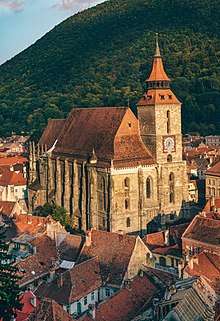
Throughout the passing of time, the German community in Romania has been actively and consistently contributing to the culture of the country. The most noteworthy examples of such contributions are visible in the following aspects:
- Romanian architecture (e.g. the picturesque Transylvanian villages with fortified churches (known in German as kirchenburgen) or some of the most renowned castles as well as several medieval town centers with local markets, all of them highly popular touristic attractions);
- Romanian language (where approximately 3% of the words in the Romanian lexis are of German origin, mainly stemming from the influence of the Transylvanian Saxons and, later on, that of Austrians);[14][15][16][17]
- Romanian literature (the first letter written in Romanian was addressed to the former early 16th century mayor of Kronstadt, Johannes Benkner, and the first Romanian language book was printed in Hermannstadt).
Royal House of Hohenzollern-Sigmaringen in Romania
In the time of Romania's transition from a middle-sized principality to a larger kingdom, members of the German House of Hohenzollern (hailing from the Swabian Principality of Hohenzollern-Sigmaringen, part contemporary Baden-Württemberg) reigned initially over the Danubian United Principalities of Wallachia and Moldavia and then, eventually, also over the unified Kingdom of Romania both during the 19th and 20th centuries. The ruling Romanian monarchs who were part of this dynastic branch were the following ones:
| King | Reign | Claim | ||||
|---|---|---|---|---|---|---|
| Nº | Portrait | Name (Born–Died) |
Reign start | Reign end | Duration | |
| 1 | 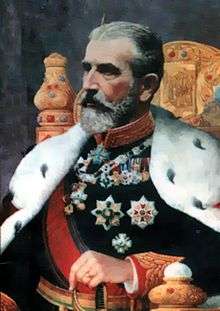 |
Carol I (1839–1914) |
15 March 1881 | 10 October 1914 | 33 years, 209 days | Ruled beforehand as Domnitor (i.e. 'Prince') (1866–1881) |
| 2 | 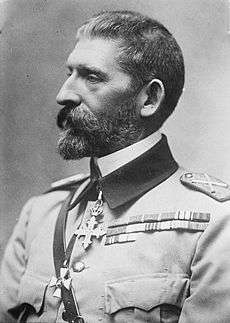 |
Ferdinand I (1865–1927) |
10 October 1914 | 20 July 1927 | 12 years, 283 days | Nephew of Carol I |
| 3 | .jpg) |
Michael I (1921–2017) |
20 July 1927 | 8 June 1930 (Deposed) |
2 years, 323 days | Grandson of Ferdinand I |
| — | 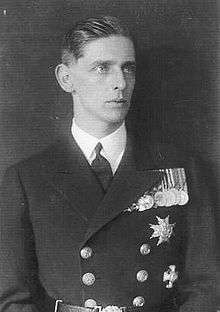 |
Prince Nicholas (1903–1978) |
20 July 1927 | 8 June 1930 (Deposed) |
2 years, 323 days | Son of Ferdinand I |
| 4 |  |
Carol II (1893–1953) |
8 June 1930 | 6 September 1940 (Abdicated) |
10 years, 90 days | Son of Ferdinand I |
| (3) |  |
Michael I (1921–2017) |
6 September 1940 | 30 December 1947 (Abdicated) |
7 years, 115 days | Son of Carol II |
Pretenders to the throne of Romania (after 1947, when King Michael I was forced to abdicate):
| Nº | Portrait | Pretender | Pretending from | Pretending until |
|---|---|---|---|---|
| 1 | 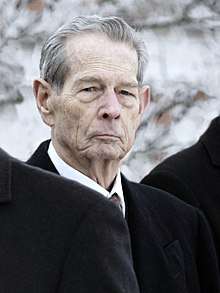 | Michael I | 30 December 1947 | 1 March 2016 |
| 2 | Margareta | 1 March 2016 | Incumbent | |
Demographics
| Historical population | ||
|---|---|---|
| Year | Pop. | ±% |
| 1887 | 50,000 | — |
| 1930 | 745,421 | +1390.8% |
| 1939 | 786,000 | +5.4% |
| 1948 | 343,913 | −56.2% |
| 1956 | 384,708 | +11.9% |
| 1966 | 382,595 | −0.5% |
| 1977 | 359,109 | −6.1% |
| 1992 | 119,462 | −66.7% |
| 2002 | 59,764 | −50.0% |
| 2011 | 36,042 | −39.7% |
| Starting with the 1930 figures, the reference is to all German-speaking groups in Romania. | ||
German minority population by settlement
The data displayed in the table below highlights notable settlements (of at least 1%) of the German minority in Romania according to the 2011 Romanian census. Note that some particular figures might be estimative.
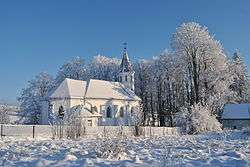
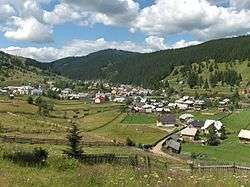
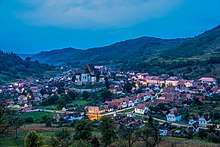
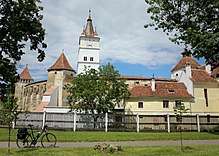
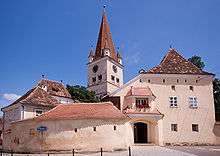
.jpg)
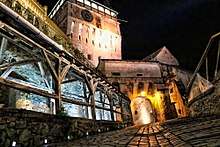
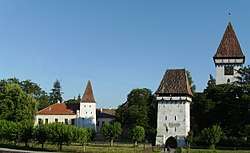
| Romanian name | German name | Percent[18] | County |
|---|---|---|---|
| Brebu Nou | Weidenthal | 30.2 | Caraș-Severin |
| Petrești | Petrifeld | 27.8 | Satu Mare |
| Urziceni | Schinal | 23.9 | Satu Mare |
| Cămin | Kalmandi | 22.5 | Satu Mare |
| Beltiug | Bildegg | 11.4 | Satu Mare |
| Tiream | Terem | 10.9 | Satu Mare |
| Laslea | Grosslasseln | 7.5 | Sibiu |
| Anina | Steierdorf | 5.6 | Caraș-Severin |
| Ațel | Hatzeldorf | 5.3 | Sibiu |
| Cârlibaba | Mariensee/Ludwigsdorf | 5.1 | Suceava |
| Saschiz | Keisd | 5.0 | Mureș |
| Biertan | Birthälm | 4.6 | Sibiu |
| Ardud | Erdeed | 4.5 | Satu Mare |
| Vișeu de Sus | Oberwischau | 4.0 | Maramureș |
| Deta | Detta | 4.0 | Timiș |
| Tomnatic | Triebswetter | 3.9 | Timiș |
| Semlac | Semlak | 3.6 | Arad |
| Peregu Mare | Deutschpereg | 3.5 | Arad |
| Sântana | Sanktanna | 2.9 | Arad |
| Jimbolia | Hatzfeld | 2.9 | Timiș |
| Jibert | Seiburg | 2.8 | Brașov |
| Măieruş | Nussbach | 2.6 | Brașov |
| Căpleni | Kaplau | 2.4 | Satu Mare |
| Lovrin | Lowrin | 2.3 | Timiș |
| Carei | Grosskarol | 2.3 | Satu Mare |
| Parța | Paratz | 2.1 | Timiș |
| Buziaș | Busiasch | 2.1 | Timiș |
| Periam | Perjamosch | 2.1 | Timiș |
| Sânnicolau Mare | Grosssanktnikolaus | 2.1 | Timiș |
| Pâncota | Pankota | 2.1 | Arad |
| Cristian | Neustadt | 1.9 | Brașov |
| Lenauheim | Schadat | 1.9 | Timiș |
| Lugoj | Logosch | 1.9 | Timiș |
| Miercurea Sibiului | Reussmarkt | 1.8 | Sibiu |
| Rupea | Reps | 1.7 | Brașov |
| Sânpetru | Petersberg | 1.7 | Brașov |
| Ungra | Galt | 1.7 | Brașov |
| Reșița | Reschitz | 1.7 | Caraș-Severin |
| Ciacova | Tschakowa | 1.6 | Timiș |
| Cisnădie | Heltau | 1.5 | Sibiu |
| Mediaș | Mediasch | 1.5 | Sibiu |
| Moșna | Meschen | 1.5 | Sibiu |
| Sighișoara | Schässburg | 1.5 | Mureș |
| Oțelu Roșu | Ferdinandsberg | 1.4 | Caraș-Severin |
| Timișoara | Temeschburg | 1.4 | Timiș |
| Nițchidorf | Nitzkydorf | 1.4 | Timiș |
| Hălchiu | Heldsdorf | 1.4 | Sibiu |
| Merghindeal | Mergeln | 1.3 | Sibiu |
| Beba Veche | Altbeba | 1.3 | Timiș |
| Iacobeni | Jakobsdorf | 1.3 | Sibiu |
| Lipova | Lippa | 1.3 | Arad County |
| Homorod | Hamruden | 1.2 | Brașov |
| Hărman | Honigberg | 1.2 | Brașov |
| Matei | Mathesdorf | 1.2 | Bistrița-Năsăud |
| Sebeș | Mühlbach | 1.1 | Alba |
| Becicherecu Mic | Kleinbetschkerek | 1.1 | Timiș |
| Caransebeș | Karansebesch | 1.1 | Caraș-Severin |
| Bod | Brenndorf | 1.1 | Brașov |
| Brateiu | Pretai | 1.0 | Brașov |
| Bocșa | Neuwerk | 1.0 | Caraș-Severin |
| Satu Mare | Sathmar | 1.0 | Satu Mare |
| Sibiu | Hermannstadt | 1.0 | Sibiu |
| Mănăstirea Humorului | Humora Kloster | 1.0 | Suceava |
| Agnita | Agnetheln | 1.0 | Sibiu |
| Hoghilag | Halvelagen | 1.0 | Sibiu |
| Dumbrăveni | Elisabethstadt | 1.0 | Sibiu |
| Șeica Mare | Marktschelken | 1.0 | Sibiu |
| Codlea | Zeiden | 1.0 | Brașov |
| Gătaia | Gattaja | 1.0 | Timiș |
| Măureni | Moritzfeld | 1.0 | Caraș-Severin |
German minority population by county
Below is represented the notable German minority population (of at least 1%) for some counties, according to the 2011 census.
| County | Percent[19] |
|---|---|
| 1.5% | |
| 1.3% | |
| 1.1% | |
| 1.1% | |
Administration, official representation, and politics
The entire German-speaking community in contemporary Romania is represented at official level by the Democratic Forum of Germans in Romania (German: Demokratisches Forum der Deutschen in Rumänien). The forum is a political platform that has a centrist ideology aiming to support the minority rights of the Germans from Romania.
Since 1989, the DFDR/FDGR has competed both in local and legislative elections, cooperating in the process with two historical parties of the Romanian politics, namely the National Liberal Party (PNL) and the Christian Democratic National Peasants' Party (PNȚCD), most notably at local administrative level, in cities such as Sibiu (German: Hermannstadt), Timișoara (German: Temeschburg), or Baia Mare (German: Frauenbach). The DFDR/FDGR also adheres to a pro-monarchic stance regarding the matter of monarchy restoration in Romania.
Until 1 January, 2007 (i.e. the date of accession of Romania to the European Union), the DFDR/FDGR was also an observing member of the European Parliament, briefly affiliated with the European People's Party Group (between January and November of the same year).
Education
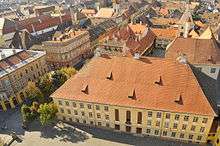
In Bucharest there are two German schools, namely Deutsche Schule Bukarest and Deutsches Goethe-Kolleg Bukarest. The Deutsche Schule Bukarest serves Kinderkrippe, Kindergarten, Grundschule, and Gymnasium (high school).[20]
In Timișoara, the Nikolaus Lenau High School was founded during the late 19th century. It was named this way in reference to Nikolaus Lenau, a Banat Swabian Romantic poet. Nowadays, the Nikolaus Lenau High School is considered the most important of its kind from Banat.[21]
In Sibiu, the Samuel von Brukenthal National College is the oldest German-language school from Romania (recorded as early as the 14th century), being also classified as a historical monument. It was subsequently renamed this way in reference to baron Samuel von Brukenthal, a Transylvanian Saxon aristocrat.
Additionally, there are two Goethe Institut cultural associations in Romania: one based in Bucharest and another one in Iași.
Media
The Allgemeine Deutsche Zeitung für Rumänien (ADZ) is the daily German-language newspaper in Romania. It is currently the only German-language newspaper from Eastern Europe.[22] Regional German-language publications also include the Banater Zeitung in Banat and the Hermannstädter Zeitung in Sibiu.
Recent history
Although the German minority in Romania has dwindled in numbers to a considerable extent since the fall of the Iron Curtain, the few but well organised Romanian-Germans who decided to remain in the country after 1989 are respected and regarded by many Romanians as a hard-working, thorough, and practical community who has contributed tremendously to the local culture and history of, most notably, Transylvania, Banat, and Bukovina, where the largest German-speaking groups once lived alongside the Romanian ethnic majority.[23]
Furthermore, the bilateral political an cultural relationships between post–1989 Romania and unified Germany increased positively after the signing of the 1992 friendship treaty between the two countries.[24] Also, on the occasion of the election of Frank Walter Steinmeier as President of Germany in 2017, incumbent Romanian president Klaus Johannis stated, among others, that: "[...] Last but not least, there is a profound friendship bounding the Romanians and the Germans, thanks mainly to the centuries-long cohabitation between the Romanians, Saxons, and Swabians in Transylvania, Banat, and Bukovina."[25]
Notable German-Romanians
Below are represented several lists comprising selected notable German-Romanians by historical region.
-
- Herta Müller (Banat Swabian), novelist and poet (Nobel Prize in Literature, 2009)
- Stefan Hell (Banat Swabian), physicist (Nobel Prize in Chemistry, 2014)
- Richard Wagner (Banat Swabian), writer
- Ernest Wichner (Banat Swabian), writer
- Gerhardt Csejka (Banat Swabian), writer
- Adam Müller-Guttenbrunn (Banat Swabian), writer
- Jacob Muschong (Banat Swabian), industrialist, business magnate, philanthropist, and investor
- Diet Sayler (Banat Swabian), painter and sculptor
- Ovidiu Ganț (Banat Swabian), Romanian politician
- Helmuth Duckadam (Banat Swabian), former football goalkeeper
- Emerich Vogl (Banat Swabian), professional football player and former captain and coach of the Romanian national football team
- Petre Steinbach (Banat Swabian), professional football player and coach
- Rudolf Bürger (Banat Swabian), professional football player, one of the few to have participated in each of the three pre-war FIFA World Cups
- Josef Posipal (Banat Swabian), professional football player who competed for the national football team of West Germany at the 1954 FIFA World Cup
- Adalbert Steiner (Banat Swabian), professional football player
- Herbert Müller (Banat Swabian), handball player and coach
- Michael Redl (Banat Swabian), Olympic handball player and professional coach
- Josef Jakob (Banat Swabian), Olympic handball player
- Werner Stöckl (Banat Swabian), Olympic handball player
- Hans-Günther Schmidt (Banat Swabian), professional handball player and coach
- Johnny Weissmueller (Banat Swabian), gold medal-winning Olympic swimmer, actor noted for the role of Tarzan
- Nikolaus Lenau (Banat Swabian), poet
- Robert Dornhelm (Banat Swabian), film and television director
- Sebastian Kräuter (Banat Swabian), Roman Catholic bishop
- Gertrude Baumstark (Banat Swabian), former worldwide chess grandmaster
- Alexandru Fölker (Banat Swabian), olympic handball player
- Hilde Lauer (Banat Swabian), olympic canoe sprinter
-
- Horst Köhler (Bessarabian German), the former President of Germany, whose parents were from Rîșcani, then Kingdom of Romania
- Ewald Heer (Bessarabian German), aerospace engineer
- Heinrich Lhotzky (Bessarabian German), Lutheran pastor and author
- Immanuel Winkler (Bessarabian German), Lutheran pastor
- Jacob Schulz (Bessarabian German), Canadian farmer and politician
- Ignaz Linl (Bessarabian German), Roman Catholic priest and founder of Sărata colony
- Alois Schertzinger (Bessarabian German), watchmaker, conductor, and co-founder of Sărata colony
- Franz Ostermann (Bessarabian German), museuologist
- Albina Ostermann (Bessarabian German), museuologist
- Markus Glaser (Black Sea German), Roman Catholic cleric, later on settled in Bessarabia and then Romania
- Karl Schmidt (partly Bessarabian German), former mayor of Chișinău, currently in the Republic of Moldova
-
- Joseph Weber (Bukovina German), Roman Catholic prelate
- Francisc Rainer (Bukovina German), physiologist and anthropologist
- Alfred Eisenbeisser (Bukovina German), professional footballer, part of Romania's squad at the 1930 FIFA World Cup
- Lothar Würzel (Bukovina German), journalist, linguist, and politician
- Elisabeth Axmann (Bukovina German), writer, literature critic, and art critic
- George Ostafi (Bukovina German), abstract painter
- Ludwig Adolf Staufe-Simiginowicz (partly Bukovina German), poet
- Stefan Hantel (partly Bukovina German), DJ and producer whose maternal grandparents stemmed from northern Bukovina
- Gregor von Rezzori (partly Bukovina German), actor, journalist, visual artist, and screenwriter
- Anton Keschmann (Bukovina German), politician in the Imperial Austrian Parliament
- Franz Ritter von Des Loges (French-Swiss), former mayor of Suceava
-
- Adolph Bachmeier (Dobrujan German), professional American soccer player
- Alexander Rodewald (Bukovina German), biologist and genetician
-
- Alexandru Flechtenmacher (Transylvanian Saxon; born in Iași), composer and conductor
- Themistocles Gluck (born in Iași), physician and surgeon
- Constantin Meissner (born in Iași), pedagogue and schoolteacher
- Grigore Cugler (born in Roznov), poet and writer
- Anna Elisabet Weirauch (born in Galați), writer
- Iancu Sasul (John the Saxon; partly Transylvanian Saxon), Prince of Moldavia between 1579 and 1582
- Matilda Cugler-Poni (partly Austrian; born in Iași), poet
- Constantin Schumacher (partly German; born in Fălticeni), professional footballer and coach
- Lică Nunweiller (born in Piatra Neamț), professional football player
-
- Klaus Johannis (Transylvanian Saxon), politician, mayor of Sibiu (German: Hermannstadt) between 2000–2014, and currently President of Romania (2014–present)
- Siegfried Mureșan (partly Transylvanian Saxon), politician, MEP for Romania (2014–present)
- Astrid Fodor (Transylvanian Saxon), politician, current mayor of Sibiu since 2014
- Josef Kappl (Transylvanian Saxon), bass player in the rock band Transsylvania Phoenix
- Arthur Coulin (Transylvanian Saxon), painter and art critic
- Oswald Thomas (Transylvanian Saxon), astronomer
- Ignaz von Born (Transylvanian Saxon), mineralogist and metallurgist
- Friedrich Grünanger (Transylvanian Saxon), architect (worked primarily in Bulgaria during the late 19th century and early 20th century)
- Johann Michael Ackner (Transylvanian Saxon), archaeologist and researcher
- Johann Sommer (Transylvanian Saxon), theologian, poet, and biographer of Jacob Heraclides, Prince of Moldavia (1561–1563)
- Christian Schesaus (Transylvanian Saxon), humanist, poet, and Lutheran pastor
- Michael Weiss (Transylvanian Saxon), historian and politician
- Johann Böhm (Transylvanian Saxon), historian
- Fronius family, (Transylvanian Saxon aristocratic family)
- Soterius family, (Transylvanian Saxon aristocratic family)
- Stamp family (Transylvanian Saxon aristocratic family)
- Johannes Honter (Transylvanian Saxon), Renaissance humanist and theologian
- Samuel von Brukenthal (Transylvanian Saxon), baron of the Holy Roman Empire, personal advisor of Maria Theresa, and Habsburg governor of the Grand Principality of Transylvania between 1774 and 1787
- Georg Daniel Teutsch (Transylvanian Saxon), Lutheran Bishop of Transylvanian Saxons during the 19th century
- Stephan Ludwig Roth (Transylvanian Saxon), Lutheran pastor and scholar
- Georg Maurer (Transylvanian Saxon), poet, essayist, and translator
- Hermann Oberth (Transylvanian Saxon), pioneer of rocket development
- Conrad Haas (Transylvanian Saxon), 16th century pioneer of rocket propulsion
- Hannah Monyer (Transylvanian Saxon), neurobiologist
- Mattis Teutsch (partly Transylvanian Saxon), painter, sculptor, graphic artist, art critic, and poet
- Friedrich Miess (Transylvanian Saxon), painter and art teacher (also mentor of Mattis Teutsch)
- Tobias Stranover (Transylvanian Saxon), painter
- Edith Soterius von Sachsenheim (Transylvanian Saxon), painter
- Margarete Depner (Transylvanian Saxon), sculptor, painter, and visual artist
- Waldemar von Baussnern (Transylvanian Saxon), composer and music teacher
- Wilhelm Georg Berger (Transylvanian Saxon), composer, musicologist, violist, and conductor
- Anita Hartig (Transylvanian Saxon), operatic soprano
- Peter Maffay (Transylvanian Saxon), rock musician
- Artur Phleps (Transylvanian Saxon), Waffen-SS general
- Michael von Melas (Transylvanian Saxon), Imperial Austrian field marshal
- Johann Martin Honigberger (Transylvanian Saxon), Imperial Austrian traveller and physician
- Michael Klein (Transylvanian Saxon), professional footballer, 8th all time most capped player for the Romanian national football team
- Roland Gunnesch (Transylvanian Saxon), Olympic handball player
- Hans Hermannstädter (Transylvanian Saxon), Olympic handball player
- Wilhelm Heidel (Transylvanian Saxon), Olympic handball player
- Otto Tellmann (Transylvanian Saxon), Olympic handball player
- Gerhard Poschner (Transylvanian Saxon), former professional football player
- Nicolae Breban (partly Transylvanian Saxon), writer
- Liviu-Dieter Nisipeanu (partly Transylvanian Saxon), Romanian and German chess grandmaster
- Rita König (Sathmar Swabian) Olympic fencer
- Monika Weber-Koszto (Sathmar Swabian), Olympic fencer
- Zita-Eva Funkenhauser (Sathmar Swabian), Olympic fencer
- Susanne König (Sathmar Swabian), fencer
- Gábor Gerstenmájer (Sathmar Swabian), professional football player
-
- Christian Tell (Transylvanian Saxon), 19th century Romanian politician, Mayor of Bucharest between 1870 and 1871
- Oscar Walter Cisek (Transylvanian Saxon; born in Bucharest), writer, diplomat, art critic
- Andrei Folbert (Transylvanian Saxon; born in Bucharest), basketball player
- Hagen Rether (Transylvanian Saxon; born in Bucharest), musician
- Ingrid Bisu (born in Bucharest), actress
- Rudolf Schweitzer-Cumpăna (Regat German from Pitești), painter
- Henric Trenk (Alemannic Swiss-born; subsequently naturalized Romanian citizen), painter
- Otto Ackermann (Alemannic Swiss from Bucharest), conductor
- Franz Kneisel (Regat German from Bucharest), violinist
- Adolf Albin (Regat German from Bucharest), chess player
- Adolf Edmund George de Herz (Regat German from Bucharest), playwright and journalist
- Henri Stahl (Regat German from Bucharest), historian and writer
- Henri H. Stahl (son of Henri Stahl), etnographer and sociologist
- Joseph Schubert, Roman Catholic bishop
- Karl Storck (Hessian-born; later on settled in Bucharest), sculptor
- Carol Storck (son of Karl Storck), sculptor
- Frederic Storck (son of Karl Storck), sculptor
- Wilhelm Knechtel (Austrian-born; later on settled in Bucharest), botanist and gardener
- Peter Herbolzheimer (born in Bucharest), musician
- Eduard Wachmann (born in Bucharest), conductor, composer, and professor
- Oscar Han (partly German; born in Bucharest), sculptor and writer
- Anneli Ute Gabanyi (Transylvanian Saxon; born in Bucharest), journalist, literary critic, and political scientist
- Gerhard Raspé (born in Bucharest), organic chemist
- Albert Streit (partly German; born in Bucharest), professional football player
Gallery
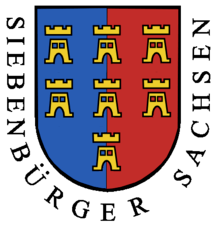 Historical coat of arms of Transylvanian Saxons
Historical coat of arms of Transylvanian Saxons Historical coat of arms of Bukovina Germans
Historical coat of arms of Bukovina Germans Historical coat of arms of Banat Swabians
Historical coat of arms of Banat Swabians Historical coat of arms of Sathmar Swabians
Historical coat of arms of Sathmar Swabians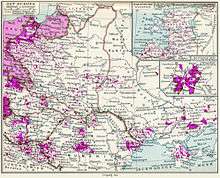 Distribution of ethnic Germans in Central/Eastern Europe in 1925, also highlighting German settlements in the Kingdom of Romania
Distribution of ethnic Germans in Central/Eastern Europe in 1925, also highlighting German settlements in the Kingdom of Romania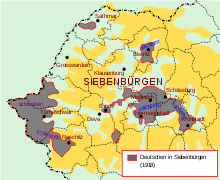 Traditional areas of settlement for the Saxons and Swabians in Transylvanian and Banat, Kingdom of Romania (early 20th century)
Traditional areas of settlement for the Saxons and Swabians in Transylvanian and Banat, Kingdom of Romania (early 20th century) A group of Bessarabian Germans (circa 1935)
A group of Bessarabian Germans (circa 1935)- A Dobrujan German in Culelia
 Keisd/Saschiz, Mureș County, example of typical rural Transylvanian Saxon settlement
Keisd/Saschiz, Mureș County, example of typical rural Transylvanian Saxon settlement_b_005.jpg) Transylvanian Saxon couple from Bistrița (Bistritz) area
Transylvanian Saxon couple from Bistrița (Bistritz) area Transylvanian Saxon lad from Gușterița (Hammersdorf)
Transylvanian Saxon lad from Gușterița (Hammersdorf) Traditional Saxon woman costume from Kronstadt/Brașov
Traditional Saxon woman costume from Kronstadt/Brașov
See also
- Germany–Romania relations
- Germany–Moldova relations
- List of ambassadors of Germany to Romania
- Romanians in Germany
- Transylvanian Saxon dialect
- Villages with fortified churches in Transylvania
- List of fortified churches in Transylvania
- List of Transylvanian Saxon localities
- Group of Transylvanian Saxons
- List of famous Transylvanian Saxons
- Sibiu Lutheran Cathedral
- Siebenbürgenlied
- Transylvanian Museum (in Gundelsheim, Baden-Württemberg, south-western Germany)
- Association of Transylvanian Saxons in Germany
- German culture
- Geographical distribution of German speakers
- Expulsion of Germans from Romania after World War II
References
- ↑ Official Romanian census from 2011
- ↑ Dr. Gerhard Reichning, Die deutschen Vertriebenen in Zahlen, Teil 1, Bonn 1995, Page 17
- ↑ Die deutschen Vertreibungsverluste. Bevölkerungsbilanzen für die deutschen Vertreibungsgebiete 1939/50. Herausgeber: Statistisches Bundesamt – Wiesbaden. - Stuttgart: Verlag W. Kohlhammer, 1958 Page 46
- ↑ Monica Barcan, Adalbert Millitz, The German Nationality in Romania (1978), page 42: "The Satu Mare Swabians are true Swabians, their place of origin being Wurttemberg. They were colonized between 1712 and 1815. Their most important settlements are Satu Mare/Sathmar and Petresti/Petrifeld in North- West Romania."
- ↑ Ministry of Foreign Affairs of Romania (3 May 2013). "The 16th session of the Romanian-German Joint Governmental Commission on the problems of German ethnics in Romania". Press release. Retrieved 17 June 2018.
- ↑ Oskar Hadbawnik, Die Zipser in der Bukowina (1968) discusses the Zipserfest held in Jakobeny in 1936 to commemorate 150 years since the Zipsers migrated to Jakobeny in 1786.
- ↑ І. Я. Яцюк, Тернопільський національний педагогічний університет ім. Володимира Гнатюка, Наукові записки. Серія “Філологічна”, УДК 81’282.4:811.112.2(477): Lexikalische Besonderheiten Deutscher Dialekte in Galizien- und der Bukowina: “Die Siedler in den ursprünglichen Bergwerksgemeinden im Südwesten der Bukowina sprachen Zipserisch und zwar Gründlerisch, wie es in der Unterzips gesprochen wurde. Dabei wurde [v] im Anlaut wie [b] ausgesprochen: Werke – berka, weh – be, Schwester – schbesta. Anlautendes [b] wurde zu [p]: Brot – prot, Brücke – prik.”
- ↑ Forumul Democrat al Germanilor din Constanța (2003). "On the Germans of Dobrogea". Institutul Cultural Român. Retrieved 1 October 2018.
- ↑ Identity and multiculturalism in the Romanian Banat, Remus Creţan, David Turnock and Jaco Woudstra, p. 17-26
- ↑ Perjamosch, Banat/List of Families Connected to Hubert Family
- ↑ Association pour la promotion de l'Alsace en Roumanie: L’étonnante histoire des alsaciens et lorrains du Banat. (in French)
- ↑ The French in Banat: Story on Tomnatic/Triebswetter
- ↑ De l'Ouest à l'Est et de l'Est à l'Ouest : les avatars identitaires des Français du Banat, Smaranda Vultur (in French)
- ↑ Dimitrie Macrea, "Originea și structura limbii române", Probleme de lingvistică română (Bucharest: Editura Științifică, 1961), 7–45: p. 32.
- ↑ Academia Română, Dicționarul limbii române moderne, ed. Dimitrie Macrea (Bucharest: Editura Academiei, 1958).
- ↑ Gabriela Pană Dindelegan, ed., The Grammar of Romanian, Oxford University Press, 2013, p. 3, ISBN 978-0-19-964492-6
- ↑ Hans Dama, "Lexikale Einflüsse im Rumänischen aus dem österreichischen Deutsch" ("Lexical influences of 'Austrian'-German on the Romanian Language") Archived 2011-08-18 at the Wayback Machine. (in German)
- ↑ Denotes percent (%) of total population
- ↑ Denotes percent (%) of total population
- ↑ "Entstehung." Deutsche Schule Bukarest. Retrieved on 20 February 2015.
- ↑ (in German) Geschichte Temeswars Schulwesen
- ↑ Allgemeine Deutsche Zeitung für Rumänien, Internationale Funkausstellung Berlin (in German)
- ↑ Ziarul Românesc.de | Klaus Iohannis: «Germanii din România sunt apreciați și respectați de toți românii» (in Romanian)
- ↑ Ministerul Afacerilor Externe - 25 de ani de la semnarea tratatului de prietenie România-Germania (in Romanian)
- ↑ Digi24.ro | Mesajul lui Iohannis pentru președintele ales al Germaniei (in Romanian)
